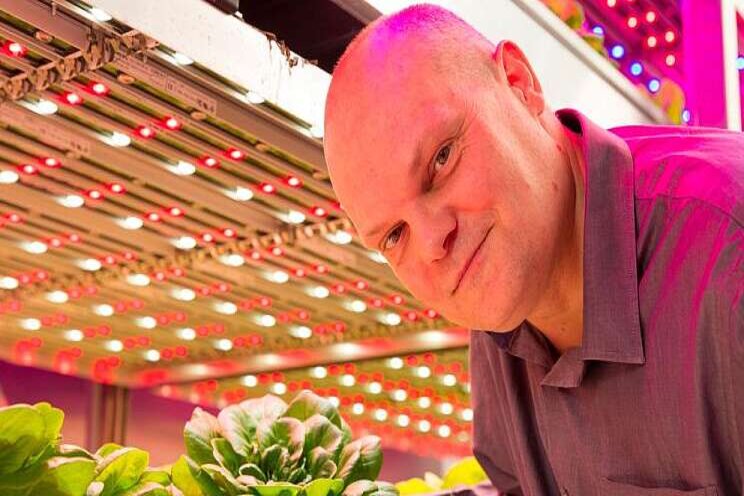Improving LED lighting to reduce energy
Added on 17 March 2021

"A major part of what makes it so constructive is that we continuously challenge each other."
Sjoerd Mentink of Philips Lighting
'LED it be' is the name of one of the programmes on which experts from Wageningen University & Research and Philips Lighting are cooperating. The goal of this project is to find ways to deploy LED lighting in greenhouses so as to reduce energy consumption by half. The chosen crop for the experiment was the tomato. The study showed that LED lamps save over 40% percent of energy on the conversion of electricity into light alone. But that was not all: an additional 30% of savings was made possible by varying colour and light distribution.
No matter what it is you wish to do with your plants, whether it's to change their vitamin C content or extend their shelf life, everything starts with photosynthesis
Sjoerd Mentink, Innovation programme manager for applications Phililips Lighting
It all starts with photosynthesis
"No matter what it is you wish to do with your plants, whether it's to change their vitamin C content or extend their shelf life, everything starts with photosynthesis," Mentink points out. "We can boost photosynthesis by optimising light distribution, intensity and wavelength spectrum. Improvements in the photosynthesis process can also be achieved by adapting other environmental conditions."

Philips Lighting is more than just a supplier of lamps. "Thanks to our R&D department, Philips Lighting Research, we are a strong knowledge partner, and have published several findings together with scientists from WUR. We are a major player in the global field of LED lighting, while Wageningen University & Research belongs to the top institutes in the global domain of plant physiology.
"This partnership therefore brings together two leading lights in our respective industries. A major part of what makes it so constructive is that we continuously challenge each other. We have the best possible facilities at our disposal along with all the preconditions necessary for us to excel - which we do."
Learning to speak each other's language
"When we started the partnership, Wageningen University & Research had never before worked with LEDs," Mentink adds. "Their people knew little about the technology - which colours could be used, which intensities, what temperatures - and we, equally, knew nothing about plant physiology. Since we understand that you can't just use any LED light and expect your plant to grow the way you want it to, we put our heads together and pooled our talents.

"We have invested heavily to ensure we have the best facilities, such as the GrowWise vertical farm, so that we would have not only the knowledge but also the resources at our disposal. Yet even that was not enough: we realised early on in the partnership that we had very different backgrounds, and this would sometimes get in the way of a smooth process. But we worked hard to establish a relationship of equals built on trust and open communication. We started jointly asking the right questions, and the right answers followed. Today, Philips Lighting and Wageningen University & Research have together been responsible for a number of world firsts."
In the end it's the people who make us successful - and we work with some very passionate people
Sjoerd Mentink, Innovation programme manager for applications Phililips Lighting
World firsts
One of these world firsts involved research into rocket leaves. "We realised that the right lighting can give this common green salad a higher concentration of vitamin C than any existing fruit. In addition, it naturally contains less sugar than fruit, making it very interesting as a healthier source of vitamins.
"We are very proud of this research. It's the kind of success story that naturally attracts talent. It's heartening to see the motivated, enthusiastic and skilled PhD students and post-docs from Wageningen University & Research work on our joint programmes every day. We are currently even involved in selecting these people, which is unique and works very well indeed.

"We have created a special chair for extraordinary professor Ernst Woltering. There are even people from Philips Lighting that have gone over to work at Wageningen University & Research and vice versa. Eventually we all became plant physiologists of sorts, while they became physicists," adds Mentink with a smile.
A goldmine
"Cultivating crops in greenhouses may be more sustainable in the long run than open-field farming. We are jointly looking for the food production techniques of the future and aim to provide the best solutions together. How can we produce food as sustainably as possible with minimal use of pesticides? The answer to this question requires business acumen as well as knowledge.
"Many questions still need to be answered in the future. What will big data mean for this domain? What role does lighting play in the shelf life and taste of products? How can we expect artificial intelligence to be involved? There's a lot to sort out. Together with the people from WUR, we are sitting on a goldmine of possibilities. I'm hoping we will continue working together for many years to come," Mentink concludes.
Sjoerd Mentink
Innovation Program Manager Applications
Philips Lighting
Source and Photo Courtesy of Wageningen University & Research
Source: Wageningen University & Research
More news















